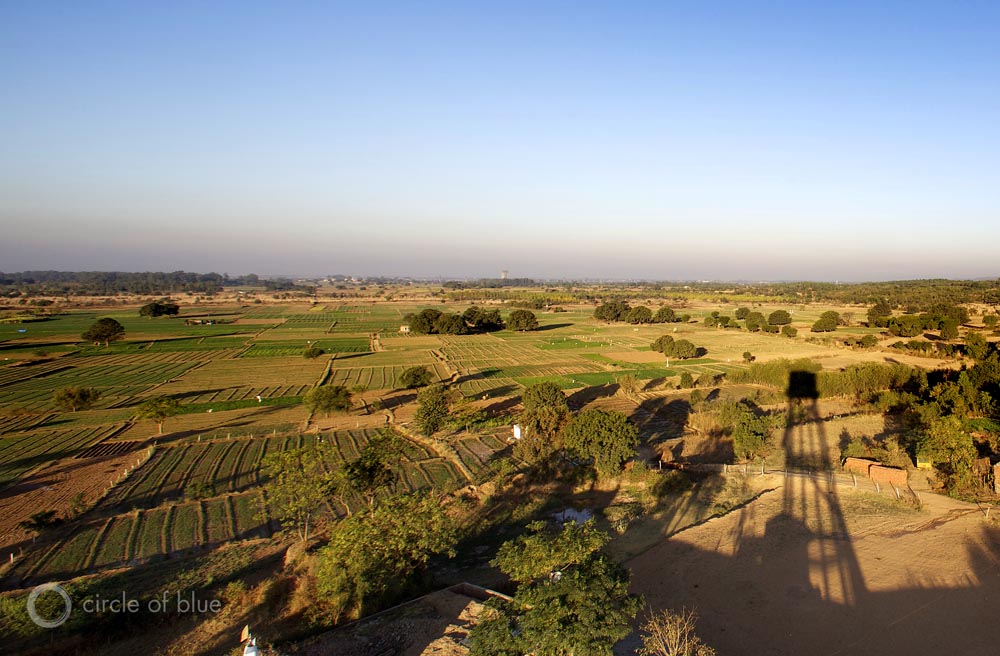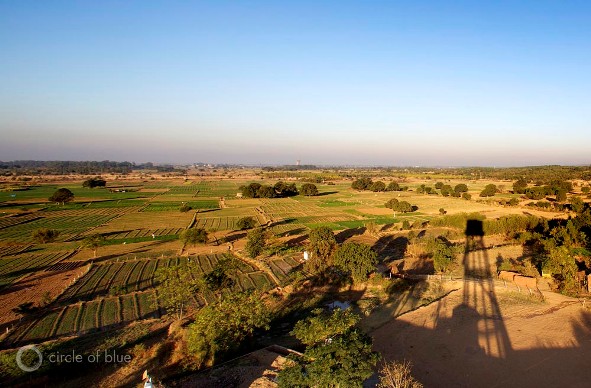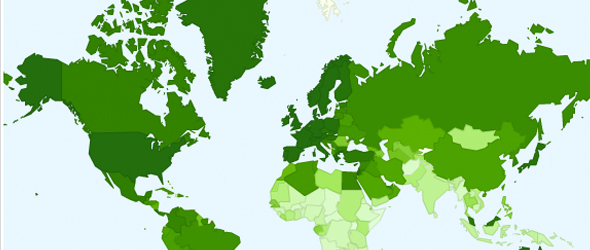Study: Global Warming Will Harm Agriculture Sooner Than Previously Thought
Increased heat and water scarcity will limit food production. Farmers and food markets can adapt, but only to a point.

By Brett Walton
Circle of Blue
As hundreds of government officials and scientists huddle this week in Yokohama, Japan to polish the final draft of a major climate report, new research is revealing the depth and urgency of the puzzle the world must solve.
Growing more food in the coming decades may be increasingly difficult sooner than expected, according to a clutch of recent climate studies. Higher average temperatures, temperature spikes during the growing season, and widespread changes in rainfall and water availability will cut farmland productivity, just when an increase is most needed to feed a world on the path to 10 billion people.
Results from at least one of the studies informed the climate report to be released on March 31 in Yokohama. The report is the latest assessment from the Intergovernmental Panel on Climate Change, the scientific body created by the United Nations in 1988 to evaluate the social and physical changes associated with a fevered Earth.
–Chris Field, co-chair
Working Group II, IPCC
A few days from now the IPCC will release the Working Group II report, which will claim that the negative consequences of rising greenhouse gas concentrations in the oceans and atmosphere – drought, disease, extinctions, and conflict, to name a few – are arriving sooner than expected, according to leaked drafts.
Five years in the making, the report will also evaluate society’s options for adapting to the altered climate future. The social assessment follows the publication last September of the Working Group I report, a review of the latest climate science. The third report in the series, on ways to slow the warming, arrives in April.
“Dealing effectively with climate change is one of the defining challenges of the 21st century,” said Chris Field, a biologist at the Carnegie Institution of Science and co-chair of Working Group II, who characterized the report as a “challenge in managing risk.”
Four studies published in the last three months reveal just how large a challenge that will be.
Food: A Growing Concern
How to feed ourselves?
The question, as old as human time, tormented hunter-gatherers and Roman emperors just as much as present-day heads of state, who worry about the prospect of more than 10 billion grumbling stomachs by 2050.
A study published March 18 in Nature Climate Change, for instance, argues that if farm management techniques do not change, crop yields – the amount of food produced per acre – will decline in both tropical and temperate regions if average local temperatures rise only 2 degrees Celsius. The previous IPCC assessment report, published in 2007, found that these small increases in temperature would be beneficial or neutral in the world’s temperate zone, a latitudinal belt between the tropics and the poles that covers most major wheat- and maize-growing regions.
The results are different this time because there are more crop models, and the models improved as scientific understanding of the underlying physical and biological processes improved, said Andy Challinor, a climate scientist at the University of Leeds and the study’s lead author.
The study was a meta-analysis – analyzing the findings of many individual investigations to glean the aggregate wisdom – and it used more than double the number of studies as the 2007 report that found small-scale warming to be beneficial.
Farmers can adapt to the environmental changes in small ways – by changing planting cycles, increasing irrigation, conserving moisture on fields, and sowing different seed varieties – but these methods will be helpful only to a point. What might be necessary is an agricultural transformation – a shift of crops from water-stressed to water-rich areas. The study mentions this possibility but does not assess it, focusing on the smaller, on-farm adaptations.
Warming above 3 degrees Celsius will almost certainly cut the productivity of key food crops, the study claims, and put annual production on a roller-coaster course of highs and lows that could undermine price stability and catalyze food riots and hoarding, as happened in the Middle East between 2007 and 2008. Even under less-severe warming, yields of maize, rice, and wheat will decline unless farmers change their behaviors.
Yield is an important number because it indicates how much food can be grown on a piece of land. If yields decrease across the board and food demand remains on its current trajectory, farmers will need to clear more land for crops. Clearing land is associated with air pollution and river degradation as well as an increase in carbon dioxide emissions.
The three crops analyzed – maize, rice, and wheat – all face different futures depending on where and how they are grown. Tropical areas fare worse than temperate zones. Rice and wheat respond well to changes in land management and planting strategies, but maize does not.
In the short term adaptation helps. Even with 2 degrees Celsius of local warming, yields for all three increased on average by 7 percent to 15 percent when farmers changed management techniques, seeds, or irrigation, the study found. But the forecast is gloomier the farther into the future one looks. By the second half of the century, warming turns sour. After 2050, roughly half of the 1,700 projections used in the analysis show yield decreases of greater than 10 percent for all crops.
Worse Effects from Heat Extremes, Water Scarcity
Bad as that is, the study may undersell the potential negative consequences of climate change.
For one, losses due to pests and diseases were not considered. Second, the study did not look explicitly at the effects of temperature spikes during key months of the growing season, a scenario that happened in the American Great Plains in summer 2012 when extreme heat and drought wrecked the corn crop.
A separate study published online March 19 in the journal Environmental Research Letters took on this very question. Researchers from the University of East Anglia in England wanted to know the effect of extreme heat during a plant’s reproductive stage.
They found that by 2080 under the most-dire climate scenario – RCP 8.5, in the lingo – yields are pummeled. Extreme heat at this critical growth junction doubles the reduction in maize yields and cuts in half any projected increase in wheat yields.
The Nature Climate Change study, though accounting for rainfall, also assumes that supplementary water is not scarce. Adding water to fields through irrigation is one of the adaptation strategies incorporated into the models. Sufficient irrigation can alleviate heat stress in a plant, like a marathon runner who maintains strength by hydrating at aid stations. In the plant world, however, that cup of water might not be waiting.
–Joshua Elliott
University of Chicago
“The assumption made in the model is that water is available, but that may not be the case,” Challinor told Circle of Blue.
Indeed, water stress is already popping up across the globe, particularly in areas important to agriculture and irrigated using diminishing supplies of groundwater – the Ganges Plain in northern India, the American Great Plains, and the North China Plain.
A study published in December in the Proceedings of the National Academy of Sciences found that declining reserves of freshwater in these major irrigation zones could equal the loss of agricultural production attributed to changes in temperature and precipitation.
“The ultimate result is that constraints in freshwater availability could double the effect of climate change,” Joshua Elliott, the study’s lead author, told Circle of Blue.
To counteract this loss of food production, the transformational shifts that were mentioned but not assessed in the Nature Climate Change study would have to occur.
Elliott said that if every bit of available fresh water in wetter regions were committed to agriculture, excluding a minimum amount to sustain rivers, then the net global effect on food production would be positive. Even some of the negative effects of climate change on total food production could be reversed. But this scenario, he noted, is overly optimistic and ignores economic obstacles such as the cost of the pipelines, canals, and energy to move all that water to the fields.
Using Water Where It Is
A final study assesses a different sort of adaptation to water scarcity in food production: the market.
Researchers at the Potsdam Institute for Climate Impact Research looked at the capacity of the global food trade to lessen the demand for water in water-stressed areas.
On balance, the global food trade conserves water, according to the study, published March 18 online in the journal Ecological Economics. Countries in the Middle East and South Asia benefit the most from importing crops that would be water-costly to grow at home.
But markets, alas, do not always operate so fluidly, nor is water sustainability the chief economic concern.
Susanne Rolinski, a study co-author, said that some countries, like India, try to produce all the food they consume, regardless if the wheat could be grown elsewhere using less water. Other countries, like Spain, she said, are in love with crops that use a lot of water but increase export earnings. And during times of panic, as in 2007 when market prices doubled or tripled for some crops, export barriers grow quicker than weeds, compounding the problem.
“Globally there is enough water to grow enough goods to provide people with food,” Rolinski told Circle of Blue. “The distribution is the problem.”
Brett writes about agriculture, energy, infrastructure, and the politics and economics of water in the United States. He also writes the Federal Water Tap, Circle of Blue’s weekly digest of U.S. government water news. He is the winner of two Society of Environmental Journalists reporting awards, one of the top honors in American environmental journalism: first place for explanatory reporting for a series on septic system pollution in the United States(2016) and third place for beat reporting in a small market (2014). He received the Sierra Club’s Distinguished Service Award in 2018. Brett lives in Seattle, where he hikes the mountains and bakes pies. Contact Brett Walton








Leave a Reply
Want to join the discussion?Feel free to contribute!